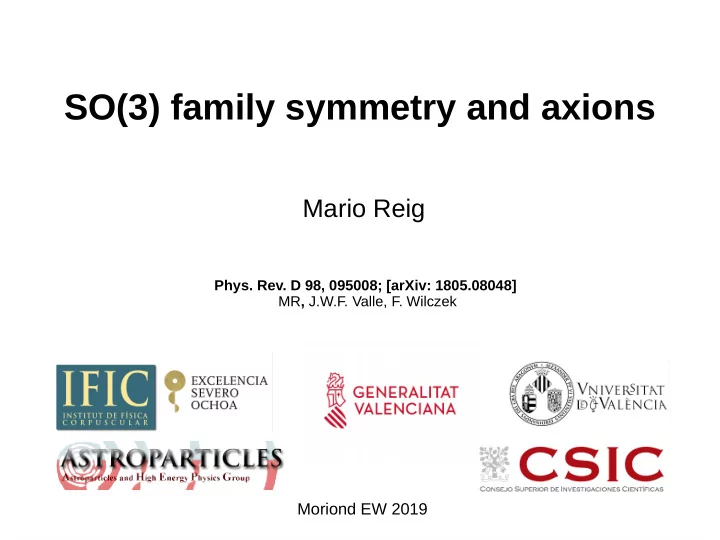

SO(3) family symmetry and axions Mario Reig Phys. Rev. D 98, 095008; [arXiv: 1805.08048] MR , J.W.F. Valle, F. Wilczek Moriond EW 2019
SO(3) as a gauge family symmetry: The threefold way The famous question of " Who ordered the muon? " has now been escalated to " Why does Nature repeat herself? " (Wilczek & Zee, 1978) 1st 2nd 3rd 1st 2nd 3rd The model: ● 2nd 1st 3rd PREDICTIONS: CKM & MASS RELATIONS ● Moriond EW 2019 Mario Reig
SO(3) as a gauge family symmetry: The threefold way The famous question of " Who ordered the muon? " has now been escalated to " Why does Nature repeat herself? " (Wilczek & Zee, 1978) 1st 2nd 3rd 1st 2nd 3rd The model: ● 2nd 1st 3rd PREDICTIONS: CKM & MASS RELATIONS ● V cb =0 M top =15 GeV Moriond EW 2019 Mario Reig
Problems of the original threefold way ● A very light top quark: M top =15 GeV ● Bottom decaying mainly to up through charged current: V cb =0 ● SO(3) broken at EW scale: unacceptable FCNC FCNC coupling Moriond EW 2019 Mario Reig
Opportunities of the original threefold way ● A very light top quark: M top =15 GeV up-type and down-type Higgses: PQ symmetry! ● Bottom decaying mainly to up through charged current: V cb =0 ● SO(3) broken at EW scale: unacceptable FCNC Break SO(3) with a SM singlet: PQ & seesaw mechanism! Moriond EW 2019 Mario Reig
The threefold way, revamped arXiv: 1805.08048 MR , J.W.F. Valle, F. Wilczek ● Extend the SM with a gauged, horizontal SO(3) symmetry. ● Use the PQ mechanism to solve strong CP problem, avoiding the wrong top quark mass prediction. ● Link flavor, PQ and lepton number symmetry breaking through the vev of a SM singlet. Moriond EW 2019 Mario Reig
Mass hierarchies ∼ Let fermions be in SO(3) triplets, f 3. ● Because of product rules, 3x3=1+3+5, we can use a singlet, ● triplet or five-plet scalar to generate fermion masses. 3 and 5 are particularly interesting: ● In this limit the 1st generation fermions are massless and the CKM is the identity Moriond EW 2019 arXiv: 1805.08048 Mario Reig
Emergence of the CKM matrix To generate 1st generation fermion mass and CKM we take ● perturbations around the minimum. Perturbations change the mass matrix: ● Generate 1st gen. Mass & quark mixing: ● Seesaw-like formula for 1st generation Mixing angles as function of q masses Moriond EW 2019 arXiv: 1805.08048 Mario Reig
Duplicated Higgs sector: mass relations and the axion In the absence of vector-like quarks, the U(1) PQ can only be anomalous ● if there is a duplicated Higgs sector: A relation between down-type quarks and charged leptons appear due ● to SO(3) symmetry. (also in: Morisi, Peinado, Shimizu, Valle, ‘11) The relation with up-type quarks is avoided thanks to the duplicated ● Higgs sector. Non-trivial flavor-axion connection Moriond EW 2019 arXiv: 1805.08048 Mario Reig
Flavor protection and the PQ scale ● Pseudo-Goldstone bosons or axions coupled to flavor lead to strong constraints, mainly coming from . ● This constraints the PQ breaking scale to be (See F. Goertz talk) ● SO(3) symmetry ensures universal PQ charges for all families. ● SO(3) gauge familons contribute to and however, this processes are suppressed by . This constraints the PQ scale to be Moriond EW 2019 arXiv: 1805.08048 Mario Reig
CONCLUSIONS ● PQ symmetry and the axion offer attractive possibilities for flavor model building ● SO(3) F turns out to be a very compelling and predictive symmetry to describe flavor. ● Interesting flavor-axion-neutrino connection appears in the SO(3) F theory. Moriond EW 2019 arXiv: 1805.08048 Mario Reig
Back-up slides
How to derive the mass relation Assumption : (exp. input) Moriond EW 2019 arXiv: 1805.08048 Mario Reig
SU(3) F as a family symmetry ● If SU(3) F is vector-like (LH and RH in triplets). Because of product rules, 3x3*=1+8, we can use a singlet or octet scalar to generate fermion masses: BAD SCENARIO FOR FERMION MASS HIERARCHIES. ● If SU(3) F is chiral (LH in triplet, RH in anti-triplet). Because of product rules, 3x3=3*+6, we can use a triplet or sextet scalar to generate fermion masses: [SU(3) F ] 3 ANOMALY UNLESS ADDING EXTRA FERMIONS. Moriond EW 2019 arXiv: 1805.08048 Mario Reig
CP violation in the quark sector ● CP violation observables are proportional to the Jarlskog invariant, J. ● CP violation arises from perturbations around minimum Moriond EW 2019 arXiv: 1805.08048 Mario Reig
Particle content of the model ● Fermions come in triplets. ● A duplicated Higgs, up and down-type, sector is introduced. ● An SM singlet, σ, breaks SO(3) and PQ at high E. Moriond EW 2019 arXiv: 1805.08048 Mario Reig
Flavor symmetries and unification ● Constraints to flavor symmetries arise if we require compatibility with unification. ● (chiral) Family SU(3) symmetry is quantumly inconsistent with minimal content of GUTs. ● Example: SO(10)xSU(3) with fermions in the (16,3) representation suffers the triangle [SU(3)] 3 anomaly. ● This leave us with only one possibility: SO(3) symmetry Moriond EW 2019 arXiv: 1805.08048 Mario Reig
Recommend
More recommend